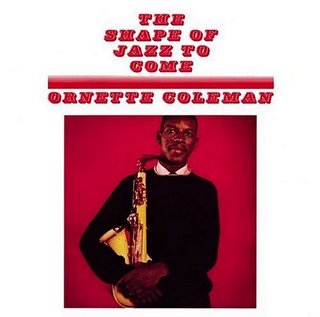
ORNETTE COLEMAN
The Shape Of Jazz To Come
Atlantic 8122-72398-2
Stereo
Recorded 22nd May 1959
1. Lonely Woman
2. Eventually
3. Peace
4. Focus On Sanity
5. Congeniality
6. Chronology
Personnel
ORNETTE COLEMAN; alto saxophone
DON CHERRY; trumpet
CHARLIE HADEN; bass
BILLY HIGGINS; drums
This is an album that can rightly claim to be one of the finest sessions of avant-garde jazz ever recorded. What makes this all the more remarkable is that it was one of the first. Featuring sidemen who would become major figures in free jazz in later years, this 1959 LP really does live up to its title as “The Shape Of Jazz To Come”.
Retrospectively, knowing what came after this, the impact of a recording such as this is bound to be lessened somewhat. Critics of the time lambasted Coleman for being unable to play, not realising that the dissonances and odd harmonic effects achieved here were entirely intentional and nothing to do with poor technique. This was, at the time, new music, and if the intervening years have lessened its impact somewhat, it’s still easy to hear how different it was from conventional hard-bop of the time.
The opening “Lonely Woman” is a fine example of what was going on here. The track is built around a haunting theme taken in (almost) unison by Coleman and Cherry. At times they peel off and head in different harmonic directions, creating strange dissonances. Cherry occasionally lags slightly behind, giving each note additional impact. These techniques have the effect of enhancing the emotional impact of the piece, to the point that you are taken inside the head of this imaginary, lonely woman.
When Coleman solos, he does so in a direction that he establishes himself. There is no need for him to follow a set harmonic path as in bop-based forms, so his playing is an organic outgrowth of the theme. This has the effect of making his playing seem logical, even in the absence of structure – this gives the whole piece a satisfying feel.
Everyone has a job to do. This is not like hard-bop, where the soloists did all the hard work with the rhythm section trailing in their wake. Haden and Higgins both have important roles to play here – this is clear from the introduction to the piece in which they set out their own themes. These may differ from those of the horns, but still play an important supporting role, and make sense in the context of the whole piece.
Ornette solos a couple of times between statements of the theme, and while Cherry’s playing is excellent in support of that theme, sadly there’s no solo space for him here.
Everyone gets solo space later on, though, with Haden particularly being in stellar form. Don Cherry’s contribution is undeniably important, but it would be several years before he reached his peak, with albums like 1966’s ‘Symphony for Improvisers’. The form of the pieces stays the same, though, with a unison statement of the theme followed by solos and a return to the theme one or more times. The tempo varies – some tracks are taken at breathtaking speed – especially ‘Eventually’, the end result being an album that swings hard and is really quite accessible for a so-called ‘free jazz’ recording.


No comments:
Post a Comment